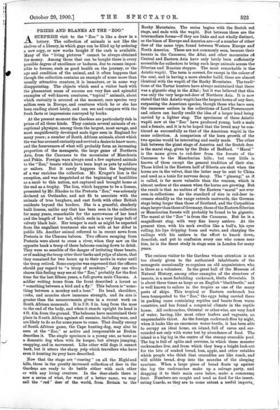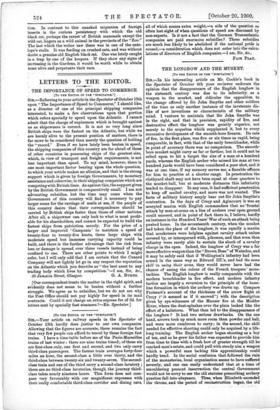PRIZES AND BLANKS AT THE "ZOO."
ASURPRISE visit to the " Zoo " is like a draw in a lottery. The collection of animals is not like the shelves of a library, in which gaps can be filled up by ordering a new copy, or new works bought if the cash is available. Many of the "living pictures" cannot be always obtained for money. Among those that can be bought there is every possible degree of excellence or badness, due to causes impos- sible to foresee, such as good health on the journey, or the age and condition of the animal, and it often happens that though the collection contains an example of some more than usually attractive creature, it is immature, or in some way disappointing. The objects which send a visitor back with the pleasantest sense of success are very fine and splendid examples of well-known creatures, " topical " animals, about which curiosity is aroused at the moment, rare species very seldom seen in Europe, and creatures which he or she has been reading about lately, and can see and compare with the fresh facts or impressions conveyed by books.
At the present moment the Gardens are particularly rich in prizes of all these kinds. They contain several animals of ex- ceptional physique, among them the largest, most savage, and most magnificently developed male tiger seen in England for many years ; a number of South African animals, about which the war has aroused curiosity and revived a desire to know more; and the forerunners of what will probably form an increasing proportion of the menagerie, the large game of Northern Asia, from the Caucasus to the mountains of Manchuria and Pekin. Foreign wars always send a few captured animals to the "Zoo," beasts which have been kept as pets by soldiers or sailors. But it rarely happens that the beginning of a war enriches the collection. Mr. Kruger's lion is the exception, and was despatched at the beginning of hostilities as a snub to this nation, not captured and brought home at the end as a trophy. The lion, which happens to be a lioness, presented by Mr. Rhodes to the Pretoria "Zoo," was solemnly declared an Outlander, and not fit to associate with the animals of true burghers, and cast forth with other British residents beyond the borders. She is a graceful, slenderly built lioness, unlike any that has been seen in the collection for many years, remarkable for the narrowness of her head and the length of her tail, which ends in a very large tuft of velvety black hair. Her temper is such as might be expected from the ungallant treatment she met with at her debut in public life. Another animal referred to in recent news from Pretoria is the Chakma baboon. Two officers escaping from Pretoria were about to cross a river, when they saw on the opposite bank a troop of these baboons coming down to drink. They were so sensible of the danger of irritating these beasts, or of making the troop utter their barks and yelps of alarm, that they remained for two hours up to their necks in water until the troop retired. Some surprise was expressed that the officers should pay regard to "a troop of monkeys." Any one who shares this feeling may see at the" Zoo," probably for the first time for the last fifteen years, a full-grown male Chacma. A soldier writing home from the front described a locust as "something between a bird and a fly." This baboon is "some- thing between a monkey and a boar." Its head, shoulders, tusks, and muscles show immense strength, and its size is greater than the measurements given in a recent work on South African mammals. It is 3 ft. 8 in. long from the nose to the end of the body, and when it stands upright its bead is 4 ft. 4 in. from the ground. The baboons have maintained their place in South Africa against all enemies, including man, and are likely to do so for some years to come. That deadly enemy of South African game, the Cape hunting-dog, may also be seen at the "Zoo," as active and irrepressible as Brehm describes it. The single specimen is a young one, as tame as a domestic dog when with its keeper, but always jumping, snapping, and in movement. Like other wild dogs it cannot bark, but it utters the sharp yelp which travellers who have seen it hunting its prey have described.
Now that the stags are " roaring " on all the Highland hills, those in the greatly increased collection of deer in the Gardens are ready to do battle either with each other or with any living creature. In the deer-sheds there is now a series of what, for want of a better name, we may call the "red" deer of the world, from Britain to the Rocky Mountains. The series begins with the Scotch red stags, and ends with the wapiti. But between these are the intermediate forms—if they are links and not wholly distinct, as the bison of Europe and America are—of a number of other deer of the same type, found between Western Europe and North America. These are not commonly seen, because their haunts in the Caucasus, the Altai, and other mountains oil Central and Eastern Asia have only lately been sufficiently accessible for collectors to bring such large animals across the Siberian and Russian steppes. The most remarkable is the, Asiatic wapiti. The term is correct, for except in the colour of the coat, and in having a more slender build, these are almost% identical with the wapiti of the Rocky Mountains. The &ad? tions of the Tartar hunters have always maintained that there. was a gigantic stag in the Altai ; but it was believed that this. was only the very large red-deer of Northern Asia. It is now stated that this Asiatic wapiti has the largest horns of any deer, surpassing the American species, though those who have seen the immense antlers in the collections of Lord Powerscourt and others can hardly credit the idea of a larger bead being carried by a lighter stag. The specimens of these Asiatic wapiti now at the " Zoo " have produced young, both a male and a female, and it is to be hoped that the breed may be con- tinued as successfully as that of the American wapiti in the same collection. A comparison of the horn growth of the two species would be interesting and easily made. The other link between the giant stags of America and the Scotch deer is the maral stag, given by the Duke of Bedford. " Maral " is the name given to red-deer from the forests of the Caucasus to the Manchurian hills; but very little is known of them except the general tradition of their size. Those killed in the Eastern half of Siberia are shot when the horns are in the velvet, that the latter may be sent to China and used as a tonic for nervous decay. The "ginseng," as it is called, is far more valuable than the venison, which is almost useless at the season when the horns are growing. But the result is that no antlers of the Eastern "maral" are ever seen in collections. As the standard of size in red-deer in- creases steadily as the range extends eastwards, the German stags being larger than those of Scotland, and the Carpathian stags larger than those of Germany, those of the Eastern Siberian or Manchurian forests will probably be found to be gigantic. The maral at the " Zoo" is from the Caucasus. But he is a magnificent stag, with very fine heavy antlers. At the present time, with his neck swollen like a bull's, his eyes rolling, his lips dripping foam and water, and charging the railings with his antlers in the effort to knock down, demolish, and put to confusion every one who comes near him, he is the finest study in stags seen in London for many years.
The curious visitor to the Gardens whose attention is not too closely given to the authorised inhabitants of the menagerie occasionally re cognises an old acquaintance, who is there as a volunteer. In the great hall of the Museum of Natural History, among other examples of the structure of insects, is a most forbidding cockroach, blatta Orientalis. It is about three times as large as an English" blackbeetle," and is well known to sailors in the tropics as one of the many pests of ships. This tropical or Eastern cockroach has been transported to the "Zoo," the eggs being carried there in packing cases containing reptiles and beasts from warm countries, and has found a congenial climate in the reptile house. All cockroaches, Oriental or otherwise, are very fond of water, having, like most other loafers and vagrants, an unquenchable thirst. As the foreign cockroach flies by night, when it looks like an enormous water-beetle, it has been able to occupy an ideal home, an island, full of caves and sur- rounded not only with water but by abundance of food. The island is a big log in the centre of the steamy crocodile pool. The log is full of splits and crevices, in which these monster cockroaches live, and from which they keep a bright look-out for the bits of soaked bread, bun, apple, and other eatables which people who think that crocodiles are like roach, and will nibble bread, drop into the muzzles of the sleeping saurians. When a large piece of bread floats up against the log the cockroaches make up a salvage party, and dragging it to their main cave below, make a communal feast. Numbers are caught and used as food for the insect- eating lizards, so they are to some extent a useful imports. tion. In contrast to this unasked migration of foreign insects is the curious persistency with which the old black rat, perhaps the rarest- of British mammals except the wild cat, lingers as a wild animal in the precincts of the "Zoo." The last which the writer saw there was in one of the ante- lope's stalls. It was feeding on crushed oats, and was without doubt a genuine old English black rat. One was lately caught in a trap by one of the keepers. If they show any signs of increasing in the Gardens, it would be worth while to obtain lome alive and perpetuate their race.







































 Previous page
Previous page